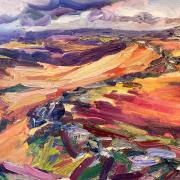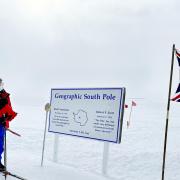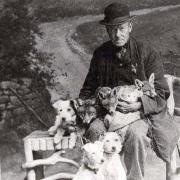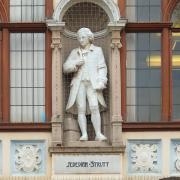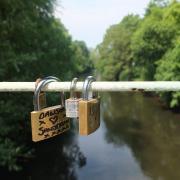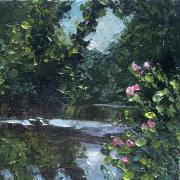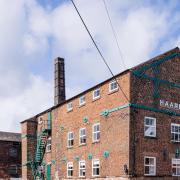Published to great acclaim, the eagerly awaited memoirs of the Dowager Duchess of Devonshire have given rise to numerous interviews, book signings and talks. Pat Ashworth visits her at home
Books are stacked everywhere at the Old Vicarage: six enormous crates in the hallway, and on the dining-room floor, mountains of loose copies which some thoughtful person has geometrically arranged at angles so that the Dowager Duchess can pick them up one by one without dislodging the others. She has been signing books for several hours a day after the instant success of Wait for Me! Memoirs of the Youngest Mitford Sister.
I expected to find her weary of talking about the book after a punishing schedule of public appearances and a clamour of interviews with the press, but far from it. She looks positively radiant. ‘What I really loved was being a sort of sandwich between Mandy and Blair,’ she says with satisfaction of the book’s publication on 3rd September. ‘It’s gone completely mad but I’ve absolutely loved it and audiences have been really interesting.’
The book is her most intimate and candid to date, a vivid and utterly compelling story of her childhood and upbringing as the seventh child catching up in a family of five older sisters and one brother; of her marriage to Andrew Cavendish, the 11th Duke of Devonshire; and of the Chatsworth inheritance and the tough but fulfilling life that followed. It’s warm and witty but she doesn’t conceal the tragedies that beset the Mitfords and the Devonshires, not least the deaths at birth of three of her children, and the difficult years of ‘eggshell walking’ that resulted from her husband’s addiction to alcohol.
She is particularly pleased with an evening at Chipping Norton Theatre the previous week, booked to more than capacity. ‘It was such fun there because the audience was in the pitch dark,’ she says. ‘I couldn’t see anything because the lights were all on me and my questioner, so I could pretend there was no-one there. It didn’t last long because they started laughing, thank goodness.’ At the Cheltenham Festival, she was looking forward to the ‘prompter’ being Simon Seligman, who worked at Chatsworth for 19 years and remains a great friend. ‘He is the very best – he’s got the fast track and when he starts laughing, everyone starts laughing,’ she says with a sparkle.
The book paints a full, fascinating and true picture of her sisters and of her parents, known affectionately as Muv and Farve. ‘The press had been so hostile and so unpleasant and had only picked up bits out of other press,’ she says. ‘They’d never interviewed either of them. It was up to somebody who knew them better than the press did – in other words, me – to try and put the record straight which I do hope I’ve done. Then of course it broadened.
‘People assumed my mother wasvague to the point of dottiness. Absolutely not true: she ran her house with every penny spent beautifully written down and accounted, all under the headings of household things. They make fascinating reading. You suddenly come across, “Tea for a thousand”. They lived at Batsford [Park] then and there were a lot of tenant farmers, so that added up to a lot of people. The recommendation for how many pots of tea is riveting, like a story from another world.’
It’s not unlike the scale of her own Golden Wedding celebrations, when she and the Duke invited to Chatsworth all Derbyshire couples who were also celebrating that year of 1991. ‘We thought there’d be two or three hundred. In the end there were 3,700 and the tent went from the house to the canal,’ she says, marvelling too at ‘Andrew’s wake, when all the people who were walking in the park just walked in, half-naked because it was the first fine day and you know how English people always take off their tops the moment there’s a ray of sun. Andrew would have been delighted. He wanted people to feel Chatsworth was theirs and wouldn’t have notices saying no prams, no dogs, don’t walk on the grass.’
Writing the book was a physically demanding task. She has macular degeneration and could only put pen to paper with the help of a specially created lap tray of a height to bring the writing surface closer to her eyes. It reads as fluently as though all the memories were just sitting in her head waiting to be transferred to paper, but she had a wealth of material to draw on and she smiles when I ask just how big the Mitford archive is.
‘When I tell you there were 12,000 letters from which to choose 600 for the book, The Mitfords: Letters Between Six Sisters... That was the marvellous thing about my sisters: they all lived abroad and so they had to write. We couldn’t telephone: it was horrendously expensive and we didn’t use it, obviously. So we wrote.
We were brought up to do it. My mother was a great letter writer, she wrote to all of us and how she did it, I do not know. All in longhand. They were so marvellous. Until my sister Unity died in 1948, when she was 34, that was how it was.’
I tell her, I can’t imagine 12,000 letters. ‘That we’ve got them all, that’s the great thing,’ she agrees. ‘We kept them because they were so funny. I couldn’t have thrown Nancy’s letters away, nor Diana’s. Or Decca’s for that matter: she was a brilliant letter-writer, less often but lovely when they came.’ Old cousins in the family still write letters: they ‘do that by nature, they still think the telephone is very expensive, which it isn’t,’ she observes, resigned to the fact that her grandchildren and great-grandchildren are unlikely to keep a written record in the same way.
There is a wonderful picture in thebook of Her Grace with all the great-grandchildren. ‘If all goes well, I’ll have 18 by Christmas. I love the picture,’ she comments. ‘If you compare it with one of Andrew’s father and grandchildren they’re all so beautifully dressed and formal and their shoes were all shone... Ours look all tousled. They are delightful but they’re very differently dressed.’
She suggests that it is the ‘pram in the hall’ that has set Chatsworth apart, the family nature of the place that means it has never been a museum. ‘Dogs and children, they soon mess up a property,’ she says with warmth. ‘They also keep you in your place; they can say things to you as their grandmother which maybe my own children wouldn’t have said. It’s a great leveller. You can’t get away with anything. I have a great-grandchild of 12 who gets first in science every term and I have absolutely no idea what he’s talking about. Especially to one who has never been to school at all.’
Her one brief experience of school, as a weekly boarder in Oxford is economically recounted in the book as, ‘I arrived at the school on a Wednesday and went home for the weekend on Friday. By that time, I had fainted in geometry, failed to understand the point of netball and been sick several times.’ She shudders at the memory of smelling ‘lino, girls and fish... cod, now the most expensive fish you can buy, produced in huge mounds with the skin on and no sauce.’ Her parents had paid for the term and so she had to stay, but she subsequently travelled in each day by train.
It was from her sisters and the people they brought home that she says she learned everything. ‘My book should have been called name-dropping. It’s full of names,’ she says of the friendships portrayed from throughout her life. They include President Kennedy, to whom she was close through the marriage of Kathleen Kennedy to Billy Hartington, her brother-in-law. Kennedy once reported his experience of ringing the family and being ‘put through to a tavern called the Devonshire Arms. It was closed.’
Two appendices in the book are her eye-witness accounts of his inauguration, at which she sat by his side to watch the parade, and his funeral, two years later. ‘I thought the immediacy of the notes I made was more interesting than trying to describe it,’ she says of the tense and shocked account of the funeral. She writes, ‘The coffin was carried by eight soldiers. It was impossible to believe that this vital, fascinating and clever person was shut up in that box. Quite impossible.’
There are many delightful glimpses of famous guests at Chatsworth, from Yehudi Menuhin, practising scales in the bedroom – ‘I thought he knew all that and would not have to bother’ – to dining with Harold Wilson, who ‘had such dirty fingernails it put me off dinner.’ But it is only at a distance of her 90 years that she has been able to write about the many deaths, most poignantly those of her mother – ‘I wondered how anyone could die without at least four daughters by her bedside’ – and all her siblings but also of the family members and contemporaries killed in the Second World War.
Derbyshire readers will take pleasure in fresh insights into the building up of Chatsworth, particularly her account of the opposition that met her idea to set up a farm shop in 1972. Nobody thought it would work but ‘tears at home and arguments elsewhere eventually won the day.’ She is a natural mimic and puts on an authentic Yorkshire accent as she recounts to me the comments of a child who came to see one of the early milking demonstrations at the farmyard: ‘I stopped a little boy from a school right in the middle of Sheffield – I don’t think he’d been in the countryside before – and I said, “What do you think of that?” He said, “That’s the most disgoosting thing I’ve ever seen in my life. I’m never going to drink milk again.”’
The sun is streaming through the windows of the Old Vicarage, flooding her cosy sitting-room with warmth. ‘It’s not half bad, is it?’ she says in contentment of the favourite furnishings she brought with her and the view of her beautiful garden. I ask her whether she feels detached from Chatsworth House now and she says, ‘Absolutely. I don’t really miss it, oddly enough, because it had become much too big for one old woman. And it was high time my son and daughter-in-law came in.’
She is still bemused by the fact that her book is a bestseller, and by the rave reviews and coverage. She managed to charm a journalist from The Guardian, who concluded at the end of his interview, ‘The contest is over and I have been soundly defeated by this 90 year old, who retains the grace she had on the ice as a child... Yes, we must sweep away centuries of privilege but I do hope Henry [the butler], Debo and her chickens survive.’
‘He was so charming,’ she says. ‘It’s very pleasing when you meet someone you reckon is going to be very hostile and they turn out not to be hostile at all. If you’ve got a name like mine, people expect a completely different sort of human being, for some reason. I can’t help my name: it’s what I’ve got and besides, I’m very proud of it and its historical connections with so many people.’
Great age is ‘a question of luck not skill and yet you are congratulated and rewarded as if you had done something clever,’ she observes in the book. In 1988, she was asked to be on the board of Bonham’s auction house and told them, ‘That’s very nice of you, but do you realise I am very old? “Oh, yes,” they said. “We know you are old but we are very young and it will do quite well.”’ And more than ‘quite well’ is how the last surviving Mitford sister is doing.
Wait For Me! by the Duchess of Devonshire, is published by John Murray (rrp �20).





